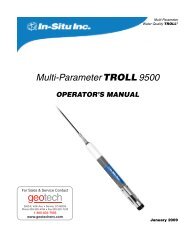TEST INSTRUCTIONS - Geotech Environmental Equipment
TEST INSTRUCTIONS - Geotech Environmental Equipment
TEST INSTRUCTIONS - Geotech Environmental Equipment
Create successful ePaper yourself
Turn your PDF publications into a flip-book with our unique Google optimized e-Paper software.
BROMINE<br />
Like chlorine, bromine is an effective germicidal agent employed in drinking<br />
water treatment, pool and spa water sanitization, food service sanitation, and<br />
other public health applications.<br />
APPLICATION: Drinking, surface, and saline waters; swimming pool water;<br />
domestic and industrial waters and wastes.<br />
RANGE: 0.00–9.00 Bromine<br />
METHOD: In buffered sample bromine reacts with diethyl-p-phenylene<br />
diamine (DPD) to produce a pink-red color in proportion to<br />
SAMPLE<br />
HANDLING &<br />
PRESERVATION:<br />
the concentration of bromine present.<br />
Bromine in aqueous solutions is not stable, and the bromine<br />
content of samples or solutions, particularly weak solutions,<br />
will rapidly decrease. Exposure to sunlight or agitation will<br />
accelerate the reduction of bromine present in such<br />
solutions. For best results start analysis immediately after<br />
sampling. Samples to be analyzed for bromine cannot be<br />
preserved or stored.<br />
INTERFERENCE: The only interfering substance likely to be encountered in<br />
water is oxidized manganese. The extent of this interference<br />
can be determined by treating a sample with sodium arsenite<br />
to destroy the bromine present so that the degree of<br />
interference can be estimated.<br />
Iodine and chlorine can also interfere, but these are not<br />
normally present unless they have been added as sanitizers.<br />
Chlorine-Bromine-Iodine 4/8 Smart2 <strong>TEST</strong> PROCEDURES 2.04

















